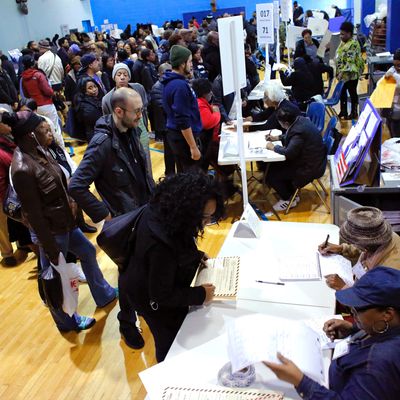
Democrats are becoming excited about the excitement of their Trump-hating voters, and hoping their enthusiasm will produce exceptional turnout in 2017’s special and off-year elections, and in 2018’s all-important midterms. That’s a big deal, because in recent years Democrats have become exceptionally dependent on segments of the electorate — principally young and minority voters — who have never shown up proportionately for non-presidential elections.
Usually this issue is discussed in the context of exit polls, but today Nate Cohn offers an analysis based on stronger voter-file data. And he has some bad news and good news for Democrats. The bad news is from the last two midterm elections:
The Democratic turnout in those elections has been extremely weak — worse than many public analysts have suggested. Democrats have depended on young and nonwhite voters, two groups that produce low turnout in midterm contests. Nationwide, Republicans were more than 20 percent likelier to vote than Democrats (defined by party vote history and registration) in 2010 and 2014, according to an Upshot analysis of voter file data from the company L2.
As it happens, I’ve written obsessively about the “midterm falloff” problem for years, and even I did not think it was that extreme!
But here’s the good news: Cohn finds data from Iowa indicating the “falloff” phenomenon for Democrats is mostly a phenomenon of midterms where Democrats control the White House.
On average, Republican turnout has been just 6 percent higher than Democratic turnout in midterm elections when Republicans have held the White House, like in 1982, 1986, 1990, 2002, and 2006. Republican turnout has been 17 percent higher than Democratic turnout in midterm elections when Democrats have held the presidency — like in 1994, 1998, 2010, and 2014. The same pattern shows up in the lower-quality data available elsewhere.
Iowa’s not the most typical state, of course; its electorate is very white. Still, if partisan midterm turnout skews one way or the other in a relatively homogenous state, it might be even more powerful where voters who do and don’t typically show up for non-presidential contests reside in larger numbers.
The data on the strong Democratic reaction to Republican presidents, to be clear, is from elections where the Republican president is not named Donald J. Trump. Thus it may be stronger than ever in 2017 and 2018.
Indeed, Cohn looks at very early non-congressional special-election data from Delaware, Iowa, and Virginia — and from early voting in the special congressional election in GA-6 — and finds that there are already signs of a turnout surge for the Donkey Party. Whether or not Democratic turnout is strong enough to flip traditionally Republican districts like GA-6, it’s an indicator that Democrats could well cast off the shackles of their large recent non-presidential turnout disadvantage.






























